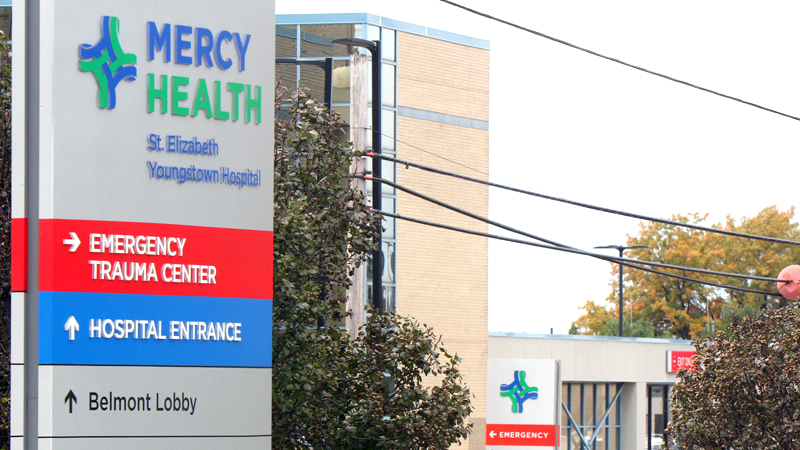St. E's Youngstown ER busier after Northside closure

By jessica Hardin
YOUNGstown
With Northside Regional Medical Center’s September closure, people have only one option when it comes to getting emergency hospital care within city limits: St. Elizabeth Youngstown Hospital’s emergency department on Belmont Avenue.
Before Northside’s closure, St. Elizabeth’s could rely on the Gypsy Lane facility in instances of heavy emergency room traffic.
“[St. Elizabeth’s] used to divert to Northside, especially in the evenings,” said Laurie Hornberger, Youngstown General Nurses Association president.
A prominent community voice opposed to Northside’s closing, Hornberger explained that the city needs multiple options when it comes to emergency care.
“We always knew we needed each other. That’s how you have to cover the area of Youngstown,” Hornberger said.
Since Northside shuttered Sept. 20, other hospitals have seen a predicted increase in visits.
St. Elizabeth on Belmont Avenue, for example, has experienced a 10 percent increase in visits. St. Elizabeth Boardman and St. Joseph Warren have each seen a 5 percent increase, and Austintown Medical Center has seen a 2 percent increase. “Patients are accessing care based on where they are in the city limits,” Mercy Health spokesman Jonathan Fauvie said.
This is, in part, because community members expect the closure to affect St. Elizabeth.
“They know how busy St. E’s is. Some choose to come to St. Joe’s. The burden hasn’t fallen on just St. E’s,” said Kathy Cook, St. Joseph Warren Hospital’s president.
Thus far, Mercy Health has been pleased with its capacity to manage the closure.
“We have been able to absorb the increase in patients since the closure. We haven’t gone on diversion,” Fauvie said.
In 2017, St. Elizabeth’s emergency room had 51,247 visitors and 40 beds. The ER’s nurse-manager, Jennifer Clutter, said the hospital adjusts emergency staffing to meet demand, according to the amount of patients who enter hourly.
Fauvie did not have statistics on wait times in St. Elizabeth’s emergency department, but anecdotally, some community members have experienced the effects of increased visitors.
Hornberger explained that her mother visited the ER recently for a blood pressure issue.
“They waited nine hours before they were completely done,” she said.
According to data collected by ProPublica ER Wait Watcher in 2016 and 2017, the average time patients spend in emergency rooms in Ohio before being sent home is 2 hours and 27 minutes.
As both a trauma center and the only hospital in the city of Youngstown, St. Elizabeth is the best option for a diverse array of conditions. “We see more acute patients first,” Clutter said.
Fauvie intends to capitalize on the increase in visits by spreading awareness of community health care options.
“It’s also an opportunity for us to educate folks on when to access an urgent-care facility compared to an emergency room and when to access a walk-in care clinic,” Fauvie said.
Urgent-care facilities can provide care for minor injuries, such as a cut that needs stitches or a sprain. Walk-in clinics are appropriate options for an ailment that needs the attention of a primary care doctor, such as a sore throat or an ear infection.
Diverting patients to more suitable touch points for care could mitigate the increase in visits and reduce ER wait times.
Some uninsured and underinsured community members, however, visit the ER because they know they will be guaranteed care.
The Emergency Medical Treatment and Labor Act requires hospital emergency departments to medically screen every patient who seeks emergency care or to stabilize or transfer those with medical emergencies regardless of health insurance status or ability to pay.
“A walk-in or urgent-care facility is not under the same rule,” St. Joseph’s Cook said.
Despite this legal loophole, Cook wants community members to know that “we wouldn’t turn someone away,” who came to a Mercy facility.
“We provide care no matter the ability to pay. We can’t ask if they have money to pay. It’s important to know that they will be treated,” Cook said.
Hornberger argues that it’s possible the community has not yet experienced the full effects of Northside’s closure.
“I still think that the whole impact won’t be seen for a couple months. You don’t need a hospital tomorrow, but you might need one in a year,” Hornberger said.
Furthermore, as Cook noted, winter is sure to bring more illness.
“We’re not into flu season yet,” Cook said.
 43
43
